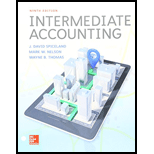
Concept explainers
Current– noncurrent classification of debt
• LO13–1, LO13–4
At December 31, 2018, Newman Engineering’s liabilities include the following:
1. $10 million of 9% bonds were issued for $10 million on May 31, 1999. The bonds mature on May 31, 2029, but bondholders have the option of calling (demanding payment on) the bonds on May 31, 2019. However, the option to call is not expected to be exercised, given prevailing market conditions.
2. $14 million of 8% notes are due on May 31, 2022. A debt covenant requires Newman to maintain current assets at least equal to 175% of its current liabilities. On December 31, 2018, Newman is in violation of this covenant. Newman obtained a waiver from National City Bank until June 2019, having convinced the bank that the company’s normal 2 to 1 ratio of current assets to current liabilities will be reestablished during the first half of 2019.
3. $7 million of 11% bonds were issued for $7 million on August 1, 1989. The bonds mature on July 31, 2019. Sufficient cash is expected to be available to retire the bonds at maturity.
Required:
What portion of the debt can be excluded from classification as a current liability (that is, reported as a noncurrent liability)? Explain.
Want to see the full answer?
Check out a sample textbook solution
Chapter 13 Solutions
GEN COMBO LOOSELEAF INTERMEDIATE ACCOUNTING; CONNECT ACCESS CARD
- Calculate Accounting income after tax?arrow_forwardSummit Enterprises had a pre-tax accounting income of $45 million during the current year. The company's only temporary difference for the year was service fees received in advance for the next year in the amount of $32 million. What would be Summit Enterprises' taxable income for the year?arrow_forwardNot use ai solution please solve things question general Accountingarrow_forward
- What was the sales price per unit?arrow_forwardTutor need step by step answerarrow_forwardEB Accessories is considering the purchase of a land and the construction of a new factory. The land, to be bought immediately, has a cost of $150,000 and the building, to be developed by the end of the first year, would cost $225,000. It is estimated that the firm's after-tax cash flow will be increased by $80,000 starting at the end of the second year, and that this incremental flow would increase at a constant rate of 20% per year over the next 10 years. What is the approximate payback period of this investment? Bella Italia, a famous Italian restaurant, is faced with two independent investment opportunities, i.e., opening of their new outlet in one of two prime locations that restaurant is considering. The company has an investment policy which requires acceptable projects to recover all costs within 4 years. The company uses the discounted payback method to assess potential projects and utilizes a discount rate of 12%. The cash flows for the two projects are as follows:…arrow_forward
 Cornerstones of Financial AccountingAccountingISBN:9781337690881Author:Jay Rich, Jeff JonesPublisher:Cengage Learning
Cornerstones of Financial AccountingAccountingISBN:9781337690881Author:Jay Rich, Jeff JonesPublisher:Cengage Learning Intermediate Accounting: Reporting And AnalysisAccountingISBN:9781337788281Author:James M. Wahlen, Jefferson P. Jones, Donald PagachPublisher:Cengage Learning
Intermediate Accounting: Reporting And AnalysisAccountingISBN:9781337788281Author:James M. Wahlen, Jefferson P. Jones, Donald PagachPublisher:Cengage Learning Financial Accounting: The Impact on Decision Make...AccountingISBN:9781305654174Author:Gary A. Porter, Curtis L. NortonPublisher:Cengage Learning
Financial Accounting: The Impact on Decision Make...AccountingISBN:9781305654174Author:Gary A. Porter, Curtis L. NortonPublisher:Cengage Learning


